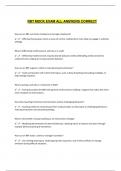RBT MOCK EXAM ALL ANSWERS CORRECT
How can an RBT use choice-making to encourage compliance?
✔️✔️ Offering choices gives clients a sense of control, making them more likely to engage in activities
willingly.
What is differential reinforcement, and how is it used?
✔️✔️ Differential reinforcement rewards desired behaviors while withholding reinforcement for
undesired ones, helping to increase positive behavior.
How can an RBT support a client in reducing impulsive behavior?
✔️✔️ Teach and practice self-control techniques, such as deep breathing and waiting strategies, to
help manage impulses.
What is pairing, and why is it important in ABA?
✔️✔️ Pairing associates the RBT with positive reinforcement, building a rapport that makes the client
more receptive to interventions.
How does teaching functional communication reduce challenging behaviors?
✔️✔️ Teaching clients to communicate their needs provides an alternative to challenging behaviors,
reducing frustration and misunderstandings.
What is the benefit of using modeling as an intervention strategy?
✔️✔️ Modeling demonstrates the desired behavior, allowing clients to observe and learn through
example before practicing it themselves.
How can an RBT teach a client to manage frustration?
✔️✔️ Use calming techniques, model appropriate responses, and reinforce efforts to manage
emotions during difficult situations.
,What is the difference between antecedent and consequence interventions?
✔️✔️ Antecedent interventions prevent challenging behaviors by modifying triggers, while
consequence interventions focus on the outcome of behaviors.
How can an RBT foster independence in academic tasks?
✔️✔️ Break down tasks into steps, use visual aids, and gradually reduce prompting to allow the client
to complete tasks independently.
What is response cost, and how is it used in behavior management?
✔️✔️ Response cost removes a positive reinforcer after an undesirable behavior, discouraging that
behavior by creating a mild consequence.
How does non-contingent reinforcement (NCR) help in managing behavior?
✔️✔️ NCR provides reinforcement at set intervals, reducing the motivation for challenging behavior
by meeting needs before they escalate.
How can visual prompts support a client with task completion?
✔️✔️ Visual prompts, like pictures or checklists, guide the client step-by-step, making tasks easier to
understand and complete.
What is a “motivating operation,” and how does it affect behavior?
✔️✔️ A motivating operation temporarily changes the effectiveness of a reinforcer, influencing how
likely a client is to engage in a behavior.
How should an RBT handle non-verbal clients in teaching communication?
✔️✔️ Use alternative communication methods like picture exchange or assistive technology, and
reinforce all efforts to communicate.
What is generalization, and why is it critical in ABA?
,✔️✔️ Generalization ensures skills learned in sessions are applied in real-life settings, making
interventions effective beyond therapy.
How can an RBT introduce new skills to a client who is resistant to change?
✔️✔️ Start with small, manageable steps, use high-quality reinforcers, and build on existing strengths
to reduce resistance.
What is intermittent reinforcement, and when is it used?
✔️✔️ Intermittent reinforcement rewards behaviors occasionally rather than every time, making the
behavior more resilient over time.
How can an RBT help a client learn daily routines?
✔️✔️ Use a consistent schedule, provide visual reminders, and reinforce each successful completion
to establish routine habits.
What is extinction burst, and how should an RBT handle it?
✔️✔️ An extinction burst is a temporary increase in challenging behavior when reinforcement is first
withheld; stay consistent, and it will likely decrease.
How can an RBT teach a client to self-monitor their behavior?
✔️✔️ Provide tools like behavior charts, explain how to track behaviors, and reinforce self-monitoring
efforts to build self-awareness.
Why is it essential to provide clear instructions to clients?
✔️✔️ Clear instructions ensure that clients understand expectations, reducing confusion and
increasing the likelihood of compliance.
How can an RBT assist in reducing repetitive behaviors?
✔️✔️ Identify the purpose of the behavior, provide alternative activities, and reinforce engagement in
a variety of tasks.
, What strategies can help a client develop coping skills?
✔️✔️ Teach relaxation techniques, provide reinforcement for practicing coping skills, and model
effective responses to stress.
How can an RBT effectively use physical prompting?
✔️✔️ Use physical prompting sparingly, ensuring it’s gradual and faded over time to promote
independence.
What is the importance of using data to track progress?
✔️✔️ Data provides objective evidence of client progress, helping to make informed decisions about
treatment effectiveness.
How can an RBT work with a client who has a history of trauma?
✔️✔️ Use a gentle, trauma-informed approach, avoiding potential triggers, and prioritize building a
trusting relationship.
What strategies help clients learn self-control?
✔️✔️ Use techniques like delayed reinforcement, teach mindfulness skills, and reinforce each instance
of successful self-control.
How can an RBT facilitate generalization of social skills?
✔️✔️ Practice skills in different settings and with various people to help the client adapt social
behaviors to real-life interactions.
How can reinforcement schedules be adjusted as skills improve?
✔️✔️ Shift from continuous to intermittent reinforcement to maintain skills without over-reliance on
frequent rewards.
What is EIBI?
-Early Intensive Behavioral Intervention, and is used to treat young children with autism




